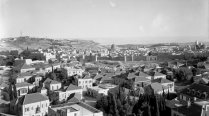Asia was 58 years old when Israel seized the West Bank, including East Jerusalem, and the Gaza Strip in 1967, and her home was one of the first to be entered by the triumphant Israeli troops. The sisters were ordered at gunpoint to leave the house and to lie on the ground while soldiers searched their home; they left havoc in their wake. Soon thereafter, Jordanian soldiers sought sanctuary at the house, and the sisters took them in. The sisters gave the men civilian clothes to wear and helped them sneak out of the house, burning their clothes surreptitiously to avoid suspicion. That action was one that family members recounted with pride.13
Asia is known to have participated in a women’s protest in March 1968; whether she was beaten and jailed, like other participants, is not known. Her opposition to the occupation was not hidden, and in 1969 she was detained at al-Moskobiyya detention center in Jerusalem for a whole day and asked to sign a statement avowing that she had not participated in protests in the past, and would not do so in the future. She refused and was released; the next day, she attended a party at the American Colony Hotel and regaled the guests with her account.14
She continued to protest Israeli policies and was frequently arrested as a result, and she kept an eye on Israeli archaeological maneuvers, such as tunneling under the Western Wall, because such activity compromised the structural integrity of nearby buildings. In the early years of the occupation, she frequently drove archaeologists to various sites and gave tours to foreign guests to show them the effects of Israel’s occupation on the holy city.
In the late 1970s, a relative who visited the Halaby sisters recalled that Asia wore pants; for a woman in her late 60s, this was unusual at the time.
The Russian Orthodox Church and community was ever present in the lives of the Halaby sisters, even though Asia reportedly once referred to religious discourse as idle chatter (kalam fadi). The sisters opened their home to get-togethers with journalists and others. They were part of an old-school women’s movement, which focused on charitable acts by upper-class women.15
By the mid- to late 1980s, Asia stopped driving. She was beginning to show signs of dementia and would remain silent when guests arrived to her home, looking to Sophie to carry on the conversation with them. Eventually she was hospitalized in a nursing home in Emmaus when Sophie, herself elderly, could no longer care for her at home.
Asia died on February 12, 1998, less than nine months after her sister. Although the sisters had been wealthy, they were swindled of their wealth by an unscrupulous lawyer. They are buried in adjacent graves in the Russian church graveyard.
The following appraisal by Ellen Fleischman, a historian of the Palestinian women’s movement between 1920 and 1948, seems like an appropriate ending for this biographical sketch of this unusual woman:

